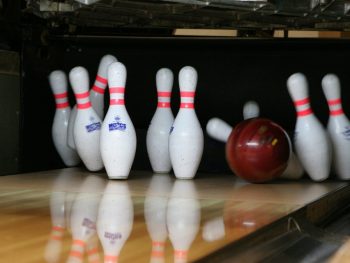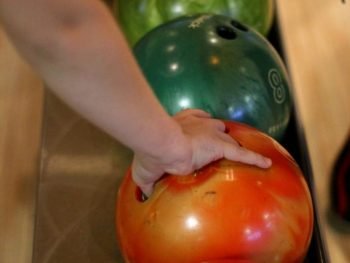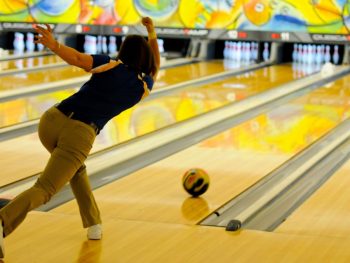Systems To Convert A Spare
Having a poor spare shot has been the downfall of many players, including professionals, as we all know. The lack of a simple system is usually the problem. While any system is better than none, most of the systems I’ve seen are complicated enough to discourage most players.
The Triax system is specifically designed to simplify the efficient conversion of spares to the point of benefiting virtually any player who knows how to count staves.
Due to the fact that mathematically there are
1,023 possible combinations in a formation of 10 pines, simplicity becomes critical.
Triax
The number one rule when shooting the spare is universal: “In any spare, you must hit the front pine!”, we will refer to this pine as the “key” pine. In essence, this makes any spare, no matter how difficult the formation, nothing more than a simple pine spare.
Here is the first simplification the Triax system provides: The player is asked to stand on a specific initial stave as shown (we’ll call it an anchor stave) for each of the 6 front “V” pines of the initial chuza formation, not including pine 1 (see illustration 1). So when using the Triax, the feet may not be adjusted to different staves!
Thus to convert the pine 10, 6 or 3 to the right of the center, as well as the 7, 4 and 2 on the side
left, the player must stand on the specific stave illustrated. This reduces the number of places we position the feet to the minimum possible, thus greatly simplifying the options while increasing the conversion potential.
Rules 2 and 3 will tell you which side of the key pine to throw other pines in the formation, or to convert splits and finally avoid cherry. But at this point, we will stick to the basic system.
Thus… we will think of all spares where the front pine (key) is to the right of the center (in the illustration, the right triangle) as “right side spares”, no matter where the additional pines that accompany the formation are and the key pines to the left of the center as “left side spares”.
Incidentally, the Triax System is designed so that all right players use the left foot to stand on the anchor stave and left players use the right foot! This is to prevent us from stopping stuck to the return of balls when we shoot the pins on the shore. (If someone insists on using the other foot, that’s fine, as long as they can be kept away from the return of balls.)
By regulation, all tables are the same width… 41 ½ inches, plus or minus 1/2″ inch… and all current tables are made with 39 staves. So, since the arrows are always between 14 and 15 feet from the foul line, all current tables have an identical layout.
This means that the starting stave (anchor) on each side of the center changes exactly 3 staves for each pine on that side. This is nothing new. It has been this way for many years. This works because according to mathematics, as long as you use the same reference in the arrows to shoot any key pine on the same side, this 3-stave displacement in the feet carries the ball to the desired key pine at all times.
The target stave (your mark)
Now we get to the point where we just don’t know one thing… what will our mark on the arrows be like? This information will have to be discovered by you through several experimental shots. This is because the mark can, and regularly happens, varies according to the player.
But normally, the marks don’t change by more than three or four staves from one player to another, so I can provide a very good approximation:
To find your specific mark (right player), start first by trying the 10 pine, stopping at the 35 stave (as shown in figure 1). He then fires a straight shot into the stave 18 approximately. If the shot on the 18 stave fails the 10 pin, change your mark to the right or left one or two staves and try again.
Keep experimenting until you hit the pine 10. This stave you used to hit the pine 10 will be your mark for the spares on the right side!
Left-handed players will do the same on their side, firing at pine 7.
Now, look at the top left and right of the diagrams in Figure 1.
Do you see the white space? This is the space in which you will write your mark once you have determined what it is. If you make a couple of copies of this figure with these blanks, you can cut them out, write your own numbers, and use the copies during your practice, without having to mark the magazine.
Use a pencil for this. Why? Remember, while it is not very common, it is possible that your brand may change over time, possibly due to a change in the deviation in walking. Until you memorize the stave numbers, you may want to keep a copy of this diagram for reference.
Straight shot for spare
This is critical, manufacturers wouldn’t make spare balls if they weren’t affordable. Oil conditions change at different points on the table, so curved shots for left or right side spares can be dangerously inaccurate.
Straight shooting is the only sure way to discount the condition of the table during the first shot.
spare shot. Last year Walter Ray Williams converted 545 single spares out of a total of 545. He attributes his success to his “rebounding” ball… purely straight.
Obviously, curved shots are necessary for central spares, where the chuza (or Brooklyn) shot is necessary.
Incidentally, the Triax System treats pine 8 as if it were 2, and pine 9 as if it were 3. A reasonably accurate straight shot will work. Also, you’ll soon discover that you don’t need to be extremely precise (except for the splits, of course, which we’ll talk about later). Normally, a slight flaw will be allowed when converting the key pine.
Exceptions
There are some exceptions, of course, but they are not many. Here are a few:
The 3-6-9-10 (right): Instead of shooting straight at pine 3 as dictated by the system, stand up to shoot pine 6 and shoot with a curve at the mark of pine 6. A lot of precision is needed for this shot, but statistics prove that this is the best way. Left-handed players, do the same (2-4-7-8). Stand up to throw the pine 4 and shoot with a curve.
The 2-8 or 2-4-8: Instead of shooting the pin 2, use the Brooklyn shot. Left-handed players, do the same for 3-9 or 3-6-9. However, if the above formations include pine 5 (as in the “bucket”), do not use the shot.
Brooklyn. Instead use the straight shot to the key pine, as dictated by the system. This is because Brooklyn shots are designed to miss pine 5, so don’t fall into that trap.
Splits 4-5-7: Place ½ on the left side of the normal Brooklyn and shoot the Brooklyn. Left-handed players, same for split 5-6-10, standing ½ stave to the right of your Brooklyn position and shoot Brooklyn.
Having said all of the above, I accept that several straight players may want to curve to 3-9 (left-handed to 2-8), but I do not recommend it. Inaccuracies due to oil variations can cause failures. Statistics indicate that a straight shot converts more of these than a curve shot.
Eliminating Cuts and Converting Splits
As mentioned in rule 1 of the Triax, the “key” pine must be hit first in all spare formations, this is designed to hit the key pine in the center of the pine. It does not include the adjustments that would be necessary to hit the “key” pine from one side or the other… a necessary issue for the conversion of spares with multiple pines without cutting out the cherry and falling into an inlet.
Let’s look at rule 2
Rule 2 effectively covers the following situation. This rule says:
To convert all spares of multiple pines, except splits, it is necessary to hit the key pine on any side that causes the ball to deviate into the accompanying pines.
This is accomplished simply by adjusting the feet one stave to the right (or left) of the normal anchor stave to shoot a given key pine, then shoot using the same mark for that key pine.
I will describe some examples of this to show you how it works: For spare 3-
6-10, you have to stand a stave to the left of the normal for pine 3, this will cause the ball to hit the right side of pine 3. This will deflect the ball into the 6-pine, pulling the 10-pine in turn. However, for the 3-5, you will have to stand a stave to the right of the normal position to throw the 3 pine, because now we want to hit the left side of the 3 pine so that the ball deviates towards the 5 pine.
For the 2-4-7, or the 2-4-5-7, it is necessary to stand a stave to the right of the normal position for pine 2 and shoot at the normal mark for pine 2. Again, this causes the ball to deflect in the desired direction… to the left side of pine 2… in turn, the 2 will shoot the 5 pine, the ball when deflected to the left of pine 2 will shoot the pines.
4 y 7.
For the 3-6-10 or 3-5-6-10, you must adjust a stave to the left of the normal position to shoot the 3 pine and shoot the mark for this pine, this will make the 3 pine shoot the 5 pine, while the ball deflects to the right and shoots the 6 and 10 pine.
It doesn’t make any difference if you’re right-handed or left-handed player. This rule applies equally to both players.
Why does it work?
Stopping at a certain stave at the beginning or near the beginning of the previous one, if a ball is repeatedly thrown with a high degree of precision over a mark (stave), the ball will reach the same point in the pines each time. So the result is as follows:
Because each adjustment of 3 staves in the previous one causes the ball to hit the center.
of the next pine (there is a lateral distance of 6 inches between pines), demonstrating that a stave fit, along with a precise throw, eliminates costly cherries, because a stave fit will move the ball 2 inches.
Accuracy
Naturally, accuracy is more important for multiple pine conversions, because a little more perfection is required to hit one side or the other of the key pine compared to hitting either side of the pine in simple conversions.
Remember, for single pine conversions you have a total 21 ½” margin of error before you fail the pine. It seems incredible, but think of it this way; the ball is about 8 ½” in diameter and it doesn’t matter which side of the pine you hit, that means it has 8 ½” x two, or 17 inches. The pine is about 4 ½” wide, and it doesn’t matter which side of the pine the ball hits.
Well, 8 ½” x two equals 17, plus 4 ½” add up to 21 ½”, there you have it.
It’s true that pine 7 and 10 may not have the same 21 ½”, but there’s still a good margin of error for these simple pines.
The pine
To better understand the concept of adjusting the feet to hit different parts of the pine, let’s look at figure 2.
Note that at its widest part, the pine has a width of about 4 ¾”. If we drew vertical lines from its narrowest point, which would be the neck of the pine, as shown, you could visualize that the pine has 3 sections: left side, center and right side. To visualize the dimensions of the pine in this way, it is more than obvious that an adjustment of a stave will result in hitting the pine on one side or the other instead of the center of the pine.
Conversion of Splits using Triax But, if we look at figure 2 in more detail, we will notice that I have not only marked the left and right sides of the pine, but also the left and right ends. So if we include these ends, the pine will actually have five parts instead of three.
Why is this important? Because it is necessary to hit the ends of the pines in order to convert splits. Splits come in two variants and their conversion becomes simple through the Triax. I said simple; this does not necessarily imply simple.
Here’s how:
Baby Splits: Always stand up and shoot the missing pine in the middle. A few examples: for 3-10, shoot 6. For 4-5, shoot 2. For 7-8, shoot 4 and so on. So for any baby split, stand on the stave that the Triax indicates to hit the missing pine.
Long Splits: For these, they will always stop to shoot the so-called “ghost” pine.
Some examples: for splits 4-7-10, stand up and shoot at pine 7. But if you have 4-10 left, shoot 7 anyway, even if it is not in the formation. This is why it is called “ghost” pine… because it is thrown even when it is not standing. This means that for 2-10 or 2-9 they stop and shoot to hit 4. For 5-7 they will shoot 3 and so on.
The reason this system works is because the width of the ball and the width of the pine are designed for the ball not to “fit” between two pine formation baby splits.
Obviously, it will also not stop touching the end of the disc if the “ghost” pine is thrown with sufficient precision.
To sum up
The success of the Triax goes back a long way. Bill Sutera, won the Arizona State Strike Force Championship with only a week of learning. Table conditions were difficult during this tournament and no one could squeal consistently. Sutera won by missing just one spare in 12 games (not counting 3 splits).
Another example is a BTM Super School student with an average of 178, an average of 223 and won a local tournament the same night the Triax learned. If I hadn’t seen the results I wouldn’t have believed it.
But, as I said, no system, even a simple and successful one like the Triax, can be completely understood through a 3 or 4-page article. Nothing compares to a one-on-one instruction on the table.
Next Steps and Where to Purchase Equipment
When you’re ready to make the leap, you can read these articles to learn what bowling equipment we recommend for every different kind of player and choose what suits you better. We try to review the best bowling equipment in the market every few weeks to keep up-to-date with the current trends.















 The 4 Factors To Improve Your Bowling Skills
The 4 Factors To Improve Your Bowling Skills